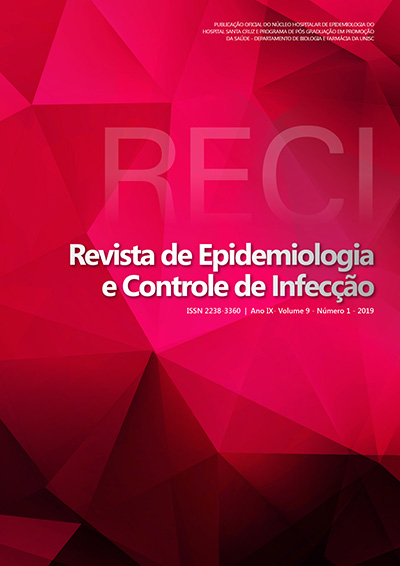Pseudo elimination of leprosy in a brazilian northeast state: analysis from regression by points of inflation and local empirical bayesian model espanhol
DOI:
https://doi.org/10.17058/reci.v9i1.11649Abstract
Background and Objectives: Alagoas is a Brazilian state in which leprosy is eliminated, but there is evidence that it is a pseudo-elimination. To analyze the temporal and spatial dynamics of leprosy in the state of Alagoas, Brazil, in between 2010 and 2015. Methods: Ecological study. Six indicators of leprosy monitoring were analyzed. Secondary data from the National System of Notifiable Diseases were used to calculate the indicators. For the temporal analysis we adopted joinpoint regression model. The trend has been ranked in increasing, decreasing or stationary. For the spatial analysis, the Local Empirical Bayesian Model and the Global and Local Moran Statistics were used. Significance was set at 5% and 95% CI. Results: The analysis by joinpoint showed a tendency to reduce the prevalence coefficient (APC=-11.2, p=0.008) and to increase the proportion of contacts examined (APC=7.0, p=0.015). The general detection coefficient, the coefficient of cases with degree II of physical incapacity and the proportion of cure showed a stationary pattern. The coefficient of detection in children under 15 years showed an inversion of the trend from 2013 (APC=7.8, p=0.011). The Moran statistic showed spatial autocorrelation, with municipalities more priority in the hinterland of the state. Conclusion: Althought being considered as eliminated in Alagoas, the high burden in the general population, the presence in children under 15 years of age and of incapacitated individuals, the fragile cure rate, the dubious quality of the contact survey and the geographical location of the state constitute the set of elements that maintain that elimination is a purely virtual process. Keywords: Leprosy. Spatial analysis. Medical informatics.Downloads
Downloads
Published
How to Cite
Issue
Section
License
The author must state that the paper is original (has not been published previously), not infringing any copyright or other ownership right involving third parties. Once the paper is submitted, the Journal reserves the right to make normative changes, such as spelling and grammar, in order to maintain the language standard, but respecting the author’s style. The published papers become ownership of RECI, considering that all the opinions expressed by the authors are their responsibility. Because we are an open access journal, we allow free use of articles in educational and scientific applications provided the source is cited under the Creative Commons CC-BY license.


